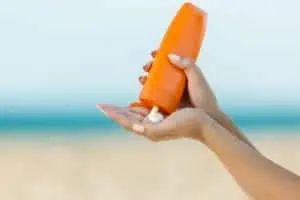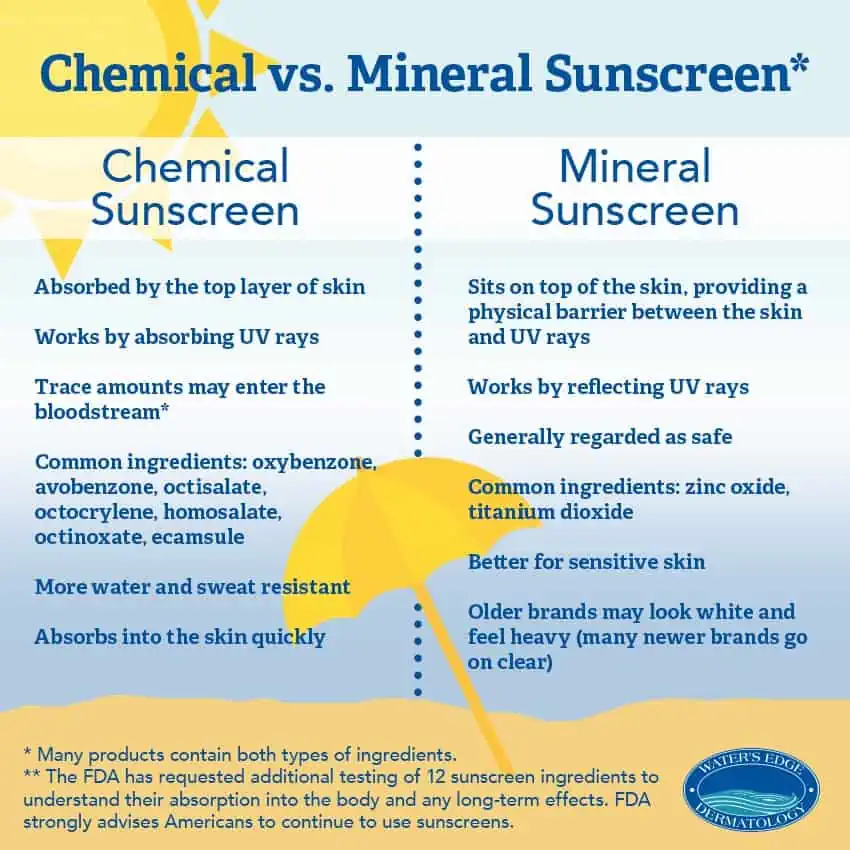
Sun and fun. They go together, particularly in the sunshine state. But sun can go with other things that aren’t so fun at all, such as pre-mature aging of your skin and even dangerous skin cancers.
Fortunately, there is a not-so-secret weapon that is easily available and known by just about everyone. It’s called sunscreen but using the wrong sunscreen in the wrong ways is a waste of your time and money, and most importantly can put your health at risk.
With so many options available, choosing the right sunscreen can be overwhelming, which is why we developed the Water’s Edge Dermatology guide to selecting the best sprays and creams to protect your skin from harmful UV rays.
What to Look For in a Sunscreen
Water’s Edge Dermatology recommends following these rules for choosing a sunscreen:
- Broad spectrum – Broad spectrum sunscreen protects the skin from both ultraviolet A (also know as UVA) and ultraviolet B (also known as UVB) rays. Both of these rays can cause skin cancer.
- SPF 30 or higher – The sun protection factor (SPF) rating indicates how well a sunscreen protects you from the sun by blocking harmful UVB rays. Choose a sunscreen with SPF 30 or higher to make sure you are protected.
- Key ingredients – Look for active ingredients like ecamsule, avobenzone, titanium dioxide, sulisobenzone or zinc oxide. Beware of products that include oxybenzone or octinoxate which are harmful to the environment. Some areas of Florida have plans to ban the sale of sunscreen with oxybenzone and octinoxate because these chemicals can damage coral reefs.
- Avoid tanning oils – They generally do not provide enough protection against the harmful effects of the sun.
How to Apply Sunscreen & How Often
If choosing the best sunscreen is half the battle, the other half is using it correctly so you get the maximum protection. Here are a few tips to help:
- One ounce of sunscreen is considered the right amount. Cover all exposed areas of the body thoroughly. Don’t skimp. Many people don’t use enough sunscreen.
- Apply sunscreen 15 to 30 minutes before going in the sun. Don’t forget the tips of the ears, feet, back of the legs and bald spot (if you have one). Reapply sunscreen every two hours and use a UV-protective lip balm to protect your lips.
- If you are exercising or are in the water, it’s a good idea to get a sunscreen that is resistant to water and sweat. The FDA defines water resistant to mean that the SPF level stays effective after 40 minutes in the water. Very water resistant means it is effective after 80 minutes of swimming. These sunscreens are not waterproof, so reapply regularly.
Additional Protection
It’s important to wear sunscreen whenever you are outside during the day. Even on an overcast day, 80 percent of the dangerous UV rays make it through. Though vitally important, sunscreen does not fully protect your skin from the sun’s rays, so also consider these additional precautions to protect your skin from sun damage:
- Stay in the shade when you can.
- Wear sunglasses to protect your eyes, preferably with polarized lenses.
- Stay inside between 10am and 4pm when the UV levels are the highest.
- Wear a hat and sun-protective clothing.
Skin is the largest barrier against infection that we have. Keeping your skin healthy and shielding it from harmful rays of the sun can help you look younger and prevent skin cancer. Also, be sure to get a skin cancer screening every year so if you do have skin cancer, it can be detected and treated early.
Play it safe and smart – sunscreen up and get a skin cancer screening!
Shop our favorite EltaMD sunscreens.
Schedule a skin cancer screening at your nearest Water’s Edge Dermatology office.






